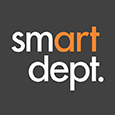smartdept. inc. gets smart(er)
We’ve made some changes at smartdept. inc., and we’re so happy about them, we want to shout from the rooftops. Or at least here in this blog post.
We’re so pleased with these tweaks, we’ve taken to calling ourselves the smart(er)dept. inc. And when we’re that proud of something, we figure it’s wise to let people know what we’re up to. So, after emailing our key contacts the following news, we lifted the juiciest bits and plunked them into this blog post. (Bonus: referring people to this post may help keep our smarties from getting hoarse when talking with candidates or clients.)
Here are a handful of changes we think you should know about!
Improved Candidate Benefits – We’ve changed our Blue Cross and Blue Shield healthcare enrollment waiting period to 90 days, down from 12 months. I think it goes without saying when it comes to healthcare, offering it sooner is smart(er). We also offer 401(k) through Merill Lynch, but we’ve been doing that for a while now.
Organizational Changes – We’ve added both speed and power to the lineup! April Levins has joined our team as Accounting and Operations Manager. She is diligently working to improve many of our internal processes. Mindy Marvin has also joined our team as National Director of Sales and Strategy. Mindy is working alongside us to help grow our national presence and create strategies to support our growth.
Electronic Timecard and Approval System – Okay, so it’s not that revolutionary. But, technically, it does make us smart(er).
Recruiting Philosophy – We’ve changed our recruiting philosophy, too. I KNOW! Under this updated model we offer the same boutique approach to service locally, while adding the ability to source and recruit nationwide. (Yup, we’re fancy.)
smartdept. inc. Strategy – If explained in detail, this would most likely draw a close comparison to the effects of tryptophan on Thanksgiving Day. Just trust me, it’s smart(er).
If you’d like to find out more about how we’ve gotten smart(er), feel free to drop us a line at hello@thesmartdept.com. I’m confident that the minutes we spend together will be a wise investment of your time (see how I didn’t use the term smart(er) there).











